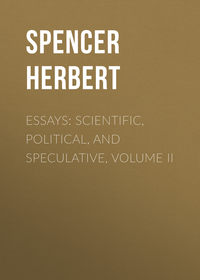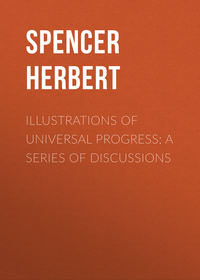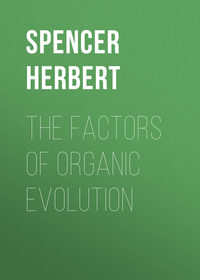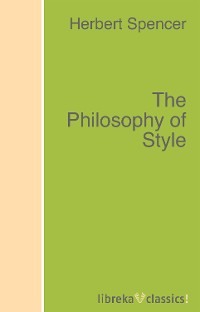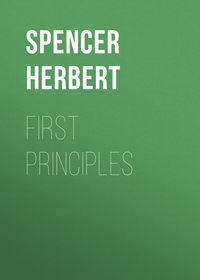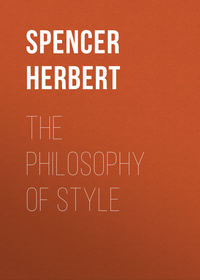 полная версия
полная версияThe Principles of Biology, Volume 1 (of 2)
Thus we may say that the development of an individual organism, is at the same time a differentiation of its parts from each other, and a differentiation of the consolidated whole from the environment; and that in the last as in the first respect, there is a general analogy between the progression of an individual organism and the progression from the lowest orders of organisms to the highest orders. It may be remarked that some kinship seems to exist between these generalizations and the doctrine of Schelling, that Life is the tendency to individuation. For evidently, in becoming more distinct from one another and from their environment, organisms acquire more marked individualities. As far as I can gather from outlines of his philosophy, however, Schelling entertained this conception in a general and transcendental sense, rather than in a special and scientific one.
§ 54. Deductive interpretations of these general facts of development, in so far as they are possible, must be postponed until we arrive at the fourth and fifth divisions of this work. There are, however, one or two general aspects of these inductions which may be here conveniently dealt with deductively.
Grant that each organism is at the outset relatively homogeneous and that when complete it is relatively heterogeneous, and it necessarily follows that development is a change from the homogeneous to the heterogeneous – a change during which there must be gone through all the gradations of heterogeneity that lie between these extremes. If, again, there is at first indefiniteness and at last definiteness, the transition cannot but be from the one to the other of these through all intermediate degrees of definiteness. Further, if the parts, originally incoherent or uncombined, eventually become relatively coherent or combined, there must be a continuous increase of coherence or combination. Hence the general truth that development is a change from incoherent, indefinite homogeneity, to coherent, definite heterogeneity, becomes a self-evident one when observation has shown us the state in which organisms begin and the state in which they end.
Just in the same way that the growth of an entire organism is carried on by abstracting from the environment substances like those composing the organism; so the production of each organ within the organism is carried on by abstracting from the substances contained in the organism, those required by this particular organ. Each organ at the expense of the organism as a whole, integrates with itself certain kinds and proportions of the matters circulating around it; in the same way that the organism as a whole, integrates with itself certain kinds and proportions of matters at the expense of the environment as a whole. So that the organs are qualitatively differentiated from each other, in a way analogous to that by which the entire organism is qualitatively differentiated from things around it. Evidently this selective assimilation illustrates the general truth, set forth and illustrated in First Principles, that like units tend to segregate. It illustrates, moreover, the further aspect of this general truth, that the pre-existence of a mass of certain units produces a tendency for diffused units of the same kind to aggregate with this mass rather than elsewhere. It has been shown of particular salts, A and B, co-existing in a solution not sufficiently concentrated to crystallize, that if a crystal of the salt A be put into the solution, it will increase by uniting with itself the dissolved atoms of the salt A; and that similarly, though there otherwise takes place no deposition of the salt B, yet if a crystal of the salt B is placed in the solution, it will exercise a coercive force on the diffused atoms of this salt, and grow at their expense. Probably much organic assimilation occurs in the same way. Particular parts of the organism are composed of special units or have the function of secreting special units, which are ever present in them in large quantities. The fluids circulating through the body contain special units of this same order. And these diffused units are continually being deposited along with the groups of like units that already exist. How purely physical are the causes of this selective assimilation, is, indeed, shown by the fact that abnormal constituents of the blood are segregated in the same way. The chalky deposits of gout beginning at certain points, collect more and more around those points. And similarly in numerous pustular diseases. Where the component units of an organ, or some of them, do not exist as such in the circulating fluids, but are formed out of elements or compounds that exist separately in the circulating fluids, the process of differential assimilation must be of a more complex kind. Still, however, it seems not impossible that it is carried on in an analogous way. If there be an aggregate of compound atoms, each of which contains the constituents A, B, C; and if round this aggregate the constituents A and B and C are diffused in uncombined states; it may be suspected that the coercive force of these aggregated compound atoms A, B, C, may not only bring into union with themselves adjacent compound atoms A, B, C, but may cause the adjacent constituents A and B and C to unite into such compound atoms, and then aggregate with the mass.
CHAPTER IIA.
STRUCTURE.21
§ 54a. As, in the course of evolution, we rise from the smallest to the largest aggregates by a process of integration, so do we rise by a process of differentiation from the simplest to the most complex aggregates. The initial types of life are at once extremely small and almost structureless. Passing over those which swarm in the air, the water, and the soil, and are now some of them found to be causes of diseases, we may set out with those ordinarily called Protozoa and Protophyta: the lowest of which, however, are either at once plants and animals, or are now one and now the other.
That the first living things were minute portions of simple protoplasm is implied by the general theory of Evolution; but we have no evidence that such portions exist now. Even admitting that there are protoplasts (using this word to include plant and animal types) which are without nuclei, still they are not homogeneous – they are granular. Whether a nucleus is always present is a question still undecided; but in any case the types from which it is absent are extremely exceptional. Thus the most general structural traits of protoplasts are – the possession of an internal part, morphologically central though often not centrally situated, a general mass of protoplasm surrounding it, and an inclosing differentiated portion in contact with the environment. These essential elements are severally subject to various complications.
In some simple types the limiting layer or cortical substance can scarcely be said to exist as a separate element. The exoplasm, distinguished from the endoplasm by absence or paucity of granules, is continually changing places with it by the sending out of pseudopodia which are presently drawn back into the general mass: the inner and outer, being unsettled in position, are not permanently differentiated. Then we have types, exemplified by Lithamœba, constituted of protoplasm covered by a distinct pellicle, which in sundry groups becomes an outer shell of various structure: now jelly-like, now of cellulose, now siliceous or calcareous. While here this envelope has a single opening, there it is perforated all over – a fenestrated shell. In some cases an external layer is formed of agglutinated sand-particles; in others of imbricated plates, as in Coccospheres; and in many others radiating spicules stand out on all sides. Throughout sundry classes the exoplasm develops cilia, by the wavings of which the creatures are propelled through the water – cilia which may be either general or local. And then this cortical layer, instead of being spherical or spheroidal, may become plano-spiral, cyclical, crosier-shaped, and often many-chambered; whence there is a transition to colonies.
Meanwhile the inclosed protoplasm, at first little more than a network or foamwork containing granules and made irregular by objects drawn in as nutriment, becomes variously complicated. In some low types its continuity is broken by motionless, vacant spaces, but in higher types there are contractile vacuoles slowly pulsing, and, as we may suppose, moving the contained liquid hither and thither; while there are types having many passive vacuoles along with a few active ones. In some varieties the protruded parts, or pseudopodia, into which the protoplasm continually shapes itself, are comparatively short and club-shaped; in others they are long and fine filaments which anastomose, so forming a network running here and there into little pools of protoplasm. Then there are kinds in which the protoplasm streams up and down the protruding spicules: sometimes inside of them, sometimes outside. Always, too, there is included in the protoplasm a small body known as a centrosome.
Lastly, we have the innermost element, considered the essential element – the nucleus. According to Prof. Lankester, it is absent from Archerina, and there are types in which it is made visible only by the aid of special reagents. Ordinarily it is marked off from the surrounding protoplasm by a delicate membrane, just as the protoplasm itself is marked off by the exoplasm from the environment. Most commonly there is a single nucleus, but occasionally there are many, and sometimes there is a chief one with minor ones. Moreover, within the nucleus itself there have of late years been discovered remarkable structural elements which undergo complicated changes.
These brief statements indicate only the most general traits of an immense variety of structures – so immense a variety that Prof. Lankester, in distinguishing the classes, sub-classes, orders, and genera in the briefest way, occupies 37 quarto pages of small type. And to give a corresponding account of Protophyta would require probably something like equal space. Thus these living things, so minute that unaided vision fails to disclose them, constitute a world exhibiting varieties of structure which it requires the devotion of a life to become fully acquainted with.
§ 54b. If higher forms of life have arisen from lower forms by evolution, the implication is that there must once have existed, if there do not still exist, transitional forms; and there follows the comment that there do still exist transitional forms. Both in the plant-world and in the animal-world there are types in which we see little more than simple assemblages of Protophyta or of Protozoa– types in which the units, though coherent, are not differentiated but constitute a uniform mass. In treating of structure we are not here concerned with these unstructured types, but may pass on to those aggregates of protoplasts which show us differentiated parts —Metaphyta and Metazoa: economizing space by limiting our attention chiefly to the last.
When, half a century ago, some currency was given to the statement that all kinds of organisms, plant and animal, which our unaided eyes disclose, are severally composed of myriads of living units, some of them partially, if not completely, independent, and that thus a man is a vast nation of minute individuals of which some are relatively passive and others relatively active, the statement met, here with incredulity and there with a shudder. But what was then thought a preposterous assertion has now come to be an accepted truth.
Along with gradual establishment of this truth has gone gradual modification in the form under which it was originally asserted. If some inhabitant of another sphere were to describe one of our towns as composed exclusively of houses, saying nothing of the contained beings who had built them and lived in them, we should say that he had made a profound error in recognizing only the inanimate elements of the town and disregarding the animate elements. Early histologists made an analogous error. Plants and animals were found to consist of minute members, each of which appeared to be simply a wall inclosing a cavity – a cell. But further investigation proved that the content of the cell, presently distinguished as protoplasm, is its essential living part, and that the cell-wall, when present, is produced by it. Thus the unit of composition is a protoplast, usually enclosed, with its contained nucleus and centrosome.
§ 54c. As above implied, the individualities of the units are not wholly lost in the individuality of the aggregate, but continue, some of them, to be displayed in various degrees: the great majority of them losing their individualities more and more as the type of the aggregate becomes higher.
In a slightly organized Metazoon like the sponge, the subordination is but small. Only those members of the aggregate which, flattened and united together, form the outer layer and those which become metamorphosed into spicules, have entirely lost their original activities. Of the rest nearly all, lining the channels which permeate the mass, and driving onwards the contained sea-water by the motions of their whip-like appendages, substantially retain their separate lives; and beyond these there exist in the gelatinous substance lying between the inner and outer layers, which is regarded as homologous with a mesoderm, amœba-form protoplasts which move about from place to place.
Relations between the aggregate and the units which are in this case permanent, are in other cases temporary: characterizing early stages of embryonic development. For example, drawings of Echinoderm larvæ at an early stage, show us the potential independence of all the cells forming the blastosphere; for in the course of further development some of these resume the primitive amœboid state, migrate through the internal space, and presently unite to form certain parts of the growing structures. But with the progress of organization independence of this kind diminishes.
Converse facts are presented after development has been completed; for with the commencement of reproduction we everywhere see more or less resumption of individual life among the units, or some of them. It is a trait of transitional types between Protozoa and Metazoa to lead an aggregate life as a plasmodium, and then for this to break up into its members, which for a time lead individual lives as generative agents; and sundry low kinds of plants possessing small amounts of structure, have generative elements – zoospores and spermatozoids – which show us a return to unit life. Nor, indeed, are we shown this only in the lowest plants; for it has recently been found that in certain of the higher plants – even in Phænogams – spermatozoids are produced. That is to say, the units resume active lives at places where the controlling influence of the aggregate is failing; for, as we shall hereafter see, places at which generation commences answer to this description.
These different kinds of evidence jointly imply that the individual lives of the units are subordinate to the general life in proportion as this is high. Where the organism is very inferior in type the unit-life remains permanently conspicuous. In some superior types there is a display of unit-life during embryonic stages in which the co-ordinating action of the aggregate is but incipient. With the advance of development the unit-life diminishes; but still, in plants, recommences where the disintegrating process which initiates generation shows the coercive power of the organization to have become small.
Even in the highest types, however, and even when they are fully developed, unit-life does not wholly disappear: it is clearly shown in ourselves. I do not refer simply to the fact that, as throughout the animal kingdom at large and a considerable part of the vegetal kingdom, the male generative elements are units which have resumed the primitive independent life, but I refer to a much more general fact. In that part of the organism which, being fundamentally an aqueous medium, is in so far like the aqueous medium in which ordinary protozoon life is carried on, we find an essentially protozoon life. I refer of course to the blood. Whether the tendency of the red corpuscles (which are originally developed from amœba-like cells) to aggregate into rouleaux is to be taken as showing life in them, may be left an open question. It suffices that the white corpuscles or leucocytes, retaining the primitive amœboid character, exhibit individual activities: send out prolongations like pseudopodia, take in organic particles as food, and are independently locomotive. Though far less numerous than the red corpuscles, yet, as ten thousand are contained in a cubic millimetre of blood – a mass less than a pin's head – it results that the human body is pervaded throughout all its blood-vessels by billions of these separately living units. In the lymph, too, which also fulfils the requirements of liquidity, these amœboid units are found. Then we have the curious transitional stage in which units partially imbedded and partially free display a partial unit-life. These are the ciliated epithelium-cells, lining the air-passages and covering sundry of the mucous membranes which have more remote connexions with the environment, and covering also the lining membranes of certain main canals and chambers in the nervous system. The inner parts of these unite with their fellows to form an epithelium, and the outer parts of them, immersed either in liquid or semi-liquid (mucus), bear cilia that are in constant motion and "produce a current of fluid over the surface they cover: " thus simulating in their positions and actions the cells lining the passages ramifying through a sponge. The partially independent lives of these units is further seen in the fact that after being detached they swim about in water for a time by the aid of their cilia.
§ 54d. But in the Metazoa and Metaphyta at large, the associated units are, with the exceptions just indicated, completely subordinated. The unit-life is so far lost in the aggregate life that neither locomotion nor the relative motion of parts remains; and neither in shape nor composition is there resemblance to protozoa. Though in many cases the internal protoplasm continues to carry on vital processes subserving the needs of the aggregate, in others vital processes of an independent kind appear to cease.
It will naturally be supposed that after recognizing this fundamental trait common to all types of organisms above the Protozoa and Protophyta, the next step in an account of structure must be a description of their organs, variously formed and combined – if not in detail yet in their general characters. This, however, is an error. There are certain truths of structure higher in generality than any which can be alleged of organs. We shall see this if we compare organs with one another.
Here is a finger stiffened by its small bones and yet made flexible by the uniting joints. There is a femur which helps its fellow to support the weight of the body; and there again is a rib which, along with others, forms a protective box for certain of the viscera. Dissection reveals a set of muscles serving to straighten and bend the fingers, certain other muscles that move the legs, and some inconspicuous muscles which, contracting every two or three seconds, slightly raise the ribs and aid in inflating the lungs. That is to say, fingers, legs, and chest possess certain structures in common. There is in each case a dense substance capable of resisting stress and a contractile substance capable of moving the dense substance to which it is attached. Hence, then, we have first to give an account of these and other chief elements which, variously joined together, form the different organs: we have to observe the general characters of tissues.
On going back to the time when the organism begins with a single cell, then becomes a spherical cluster of cells, and then exhibits differences in the modes of aggregation of these cells, the first conspicuous rise of structure (limiting ourselves to animals) is the formation of three layers. Of these the first is, at the outset and always, the superficial layer in direct contact with the environment. The second, being originally a part of the first, is also in primitive types in contact with the environment, but, being presently introverted, forms the rudiment of the food-cavity; or, otherwise arising in higher types, is in contact with the yelk or food provided by the parent. And the third, presently formed between these two, consists at the outset of cells derived from them imbedded in an intercellular substance of jelly-like consistence. Hence originate the great groups classed as epithelium-tissue, connective tissue (including osseous tissue), muscular tissue, nervous tissue. These severally contain sub-kinds, each of which is a complex of differentiated cells. Being brief, and therefore fitted for the present purposes, the sub-classification given by Prof. R. Hertwig may here be quoted; —
"The physiological character of epithelia is given in the fact that they cover the surfaces of the body, their morphological character in that they consist of closely compressed cells united only by a cementing substance.
"According to their further functional character epithelia are divided into glandular epithelia (unicellular and multicellular glands), sensory, germinal, and pavement epithelia.
"According to the structure are distinguished one-layered (cubical, cylindrical, pavement epithelia) and many-layered epithelia, ciliated and flagellated epithelia, epithelia with or without cuticle.
"The physiological character of the connective tissues rests upon the fact that they fill up spaces between other tissues in the interior of the body.
"The morphological character depends upon the presence of the intercellular substance.
"According to the quantity and the structure of the intercellular substance the connective substances are divided into (1) cellular (with little intercellular substance); (2) homogeneous; (3) fibrillar connective tissue; (4) cartilage; (5) bone.
"The physiological character of muscular tissue is contained in the increased capacity for contraction.
"The morphological character is found in the fact that the cells have secreted muscle-substance.
"According to the nature of the muscle-substance are distinguished smooth and cross-striated muscle-fibres.
"According to the character and derivation of the cells (muscle-corpuscles) the musculature is divided into epithelial (epithelial muscle-cells, primary bundles) and connective-tissue muscle cells (contractile fibre-cells).
"The physiological character of nervous tissue rests upon the transmission of sensory stimuli and voluntary impulses, and upon the co-ordination of these into unified psychic activity.
"The conduction takes place by means of nerve-fibres (non-medullated and medullated fibrils and bundles of fibrils); the co-ordination of stimuli by means of ganglion-cells (bipolar, multipolar ganglion-cells)." (General Principles of Zoology, pp. 117-8.)
But now concerning cells out of which, variously modified, obscured, and sometimes obliterated, tissues are formed, we have to note a fact of much significance. Along with the cell-doctrine as at first held, when attention was given to the cell itself rather than to its contents, there went the belief that each of these morphological units is structurally separate from its neighbours. But since establishment of the modern view that the essential element is the contained protoplasm, histologists have discovered that there are protoplasmic connexions between the contents of adjacent cells. Though cursorily observed at earlier dates, it was not until some twenty years ago that in plant-tissues these were clearly shown to pass through openings in the cell-walls. It is said that in some cases the openings are made, and the junctions established, by a secondary process; but the implication is that usually these living links are left between multiplying protoplasts; so that from the outset the protoplasm pervading the whole plant maintains its continuity. More recently sundry zoologists have alleged that a like continuity exists in animals. Especially has this been maintained by Mr. Adam Sedgwick. Numerous observations made on developing ova of fishes have led him to assert that in no case do the multiplying cells so-called – blastomeres and their progeny – become entirely separate. Their fission is in all cases incomplete. A like continuity has been found in the embryos of many Arthropods, and more recently in the segmenting eggs and blastulæ of Echinoderms. The syncytium thus formed is held by Mr. Sedgwick to be maintained in adult life, and in this belief he is in agreement with sundry others. Bridges of protoplasm have been seen between epithelium-cells, and it is maintained that cartilage-cells, connective tissue cells, the cells forming muscle-fibres, as well as nerve-cells, have protoplasmic unions. Nay, some even assert that an ovum preserves a protoplasmic connexion with the matrix in which it develops.




